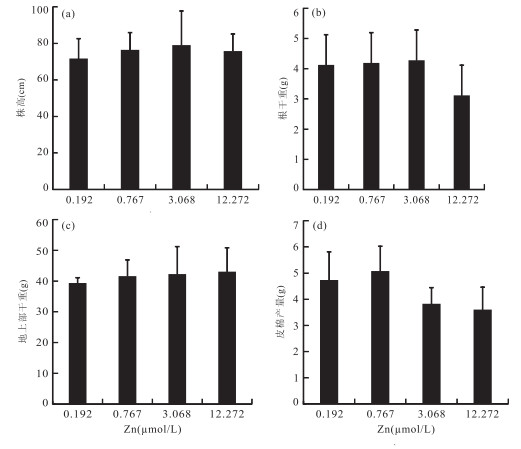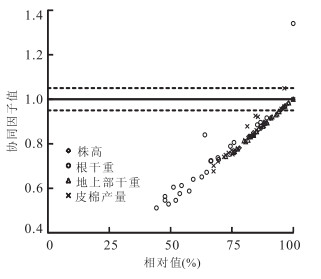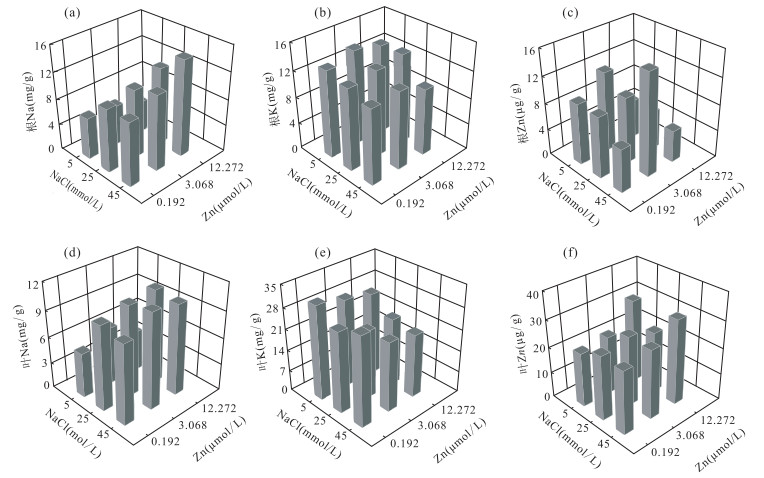Effects of NaCl and Zn on Growth and Nutrient Elements Uptake of Cotton
-
摘要: 微咸水在西北干旱区广泛分布, 越来越多地被运用于灌溉棉花(Gossypium hirsutum L.)等作物.微咸水中NaCl和微量元素含量比淡水高, 有关NaCl和微量元素各自对棉花生长的影响已有大量研究, 而他们对棉花生长的相互作用研究比较缺乏.选取对棉花生长作用敏感的NaCl和微量元素Zn, 开展不同NaCl和Zn浓度灌溉水盆栽试验.结果表明, 缺Zn环境下, 在灌溉水电导率为2.90~3.95 dS/m的范围内, 随着电导率增大, NaCl促进棉花根和地上部生长及皮棉产量增加.富Zn环境下, 灌溉水电导率大于5.04 dS/m时, 随着电导率增大皮棉产量明显下降.在灌溉水中Zn浓度为0.192 0~3.068 0 μmol/L的范围内, Zn浓度越大棉花营养生长越快; 大于0.767 6 μmol/L时, 随着Zn浓度增大皮棉产量下降.灌溉水中NaCl和Zn对棉花生长和产量的影响作用, 表现为相互拮抗作用关系.棉花叶的Ca、K、Mg、B和Fe含量以及铃的Cu和Zn含量高于其他组织, Na和Mn不易迁移, 易富集在棉花根部.Zn在盐胁迫条件下影响棉花对营养元素的吸收, 使棉花体内相关营养元素含量发生变化, 进而影响棉花生长及产量.Abstract: Brackish water distributes widely in arid area of Northwest China and the NaCl and trace element contents in brackish water are higher than those in fresh water. Cotton (Gossypium hirsutum L.) is likely to be affected by simultaneous NaCl and manganese toxicity stress when irrigated with brackish water. The crop yields including cotton (Gossypium hirsutum L.) are usually reduced by poor quality of irrigation water or the low contents of nutrient elements in soil. Many experiments indicate that some salinities in irrigation water or soil will affect the cotton growth and yield, and the predominant salt damage to cotton plant is from sodium (Na+). Meanwhile proper nutrient supply for cotton plant, especially trace elements for cotton, is important. Cotton diseases and abnormal growth are caused by lack or excess of trace elements. However, it remains beyond our full understanding as to the combined effect of salinity and trace elements on cotton growth and its uptake of nutrient elements. Thus we selected the trace element zinc which is sensitive to cotton growth, and conducted a pot experiment including 24 different treatments in irrigation with 6 NaCl levels (0 mmol/L, 5 mmol/L, 15 mmol/L, 25 mmol/L, 35 mmol/L and 45 mmol/L) and 4 Zn levels (0.192 0 μmol/L, 0.767 6 μmol/L, 3.068 0 μmol/L and 12.272 0 μmol/L) in three replicates randomly in a greenhouse at Wuhan Botanical Garden, Chinese Academy of Sciences. During the experiment, cotton growth of different treatments was measured every ten days after germination and cotton plants were harvested 197 days after sowing. The cotton bolls were harvested and air dried and weighted the wool without seeds to calculate the lint yields. Cotton samples of roots, stems, leaves and fruits were brushed to remove the sand and dusts, rinsed with deionized water; oven dried at 70 ℃ for two days and weighed dry weight. The dry matters of cotton for each treatment were triturated and sampled 0.5 g for acid digestion. Twenty-seven elements were measured in triplicate by ICP-OES (ICAP6300, Thermo Scientific, England). Nine of the 27 elements i.e. K, Ca, Mg, Na, B, Cu, Fe, Mn and Zn (cotton nutrient elements) are chosen for analysis in this paper. The results show that salinity promoted cotton root, steam growth and cotton lint yields when electrical conductivities (EC) of irrigation water fell in the range of 2.90 to 3.95 dS/m in the zinc deficiency environment. While in the zinc-rich environment, salinity inhibited cotton lint yields when EC was greater than 5.04 dS/m. Cotton plant vegetative growth become faster when Zn concentration of irrigation water in the range of 0.192 to 3.068 μmol/L, while when Zn concentration was greater than 0.767 μmol/L would cause cotton plant lint yields decline. Analysis of variance among cotton growth, root and stem dry weight parameters revealed significant influence by salinity effect but not by Zn. Cotton lint yield parameters revealed that the effect of Zn was more obvious than salinity. Interactive effect on cotton growth and yield between NaCl and Zn in the irrigation water was not observed but antagonistic effect was observed. Contents of nutrient elements Ca, K, Mg, B and Fe, in cotton leaves were higher than those in other organizations. Nutrient elements Cu and Zn in cotton bolls were higher than other organizations. Nutrient elements Na and Mn were not so movable that they are easily accumulated in roots. Zn concentration levels in irrigation water under salinity stress affected the nutrient elements uptake of cotton, caused different contents of nutrient elements in cotton, and then influenced cotton growth and yields.
-
Key words:
- cotton /
- NaCl-stress /
- zinc /
- antagonistic effect /
- nutrient element /
- absorption /
- trace element /
- environment.
-
表 1 NaCl和Zn对棉花生长和产量交互作用两因子方差分析的显著性水平检验P值
Table 1. P values for the two-way analyses of variance conduct to determine the interactive effects of NaCl and Zn on the cotton growth and yields
来源 株高 根干重 地上部 皮棉产量 (%) (g) (g) (g) P值 NaCl 0.015 0.001 0.010 0.965 Zn 0.972 0.315 0.529 0.772 NaCl+Zn 1.000 0.137 0.998 0.848 表 2 不同处理下棉花株高、干物质重和皮棉产量相对值
Table 2. The relative growth, dry weigh and lint yields of cotton in different treatments
Na(mmol/L) Zn(μmol/L) 株高(cm) 干重(%) 根 地上部 皮棉产量 0 0.192 90.73 75.87 91.39 88.71 5 0.192 96.04 66.54 90.89 96.35 15 0.192 87.92 85.37 94.04 100.00 25 0.192 83.71 66.36 82.01 74.89 35 0.192 86.85 44.24 79.89 73.63 45 0.192 81.75 47.71 72.46 88.38 0 0.767 96.74 89.21 96.63 95.18 5 0.767 95.07 64.72 87.61 67.49 15 0.767 85.08 74.04 83.55 77.47 25 0.767 76.23 62.71 75.62 80.42 35 0.767 88.45 69.29 82.56 88.38 45 0.767 82.89 74.41 76.90 77.33 0 3.068 100.00 86.65 98.17 71.76 5 3.068 96.61 69.65 94.25 82.53 15 3.068 89.19 57.59 83.80 88.06 25 3.068 83.97 52.10 85.08 85.57 35 3.068 86.87 59.23 80.62 81.26 45 3.068 78.09 49.18 76.08 72.46 0 12.272 95.85 54.48 100.00 67.54 5 12.272 98.04 47.71 92.96 85.01 15 12.272 83.14 53.75 89.40 75.27 25 12.272 88.01 51.19 83.85 96.35 35 12.272 85.99 100.00 93.38 84.59 45 12.272 82.45 63.99 81.62 69.32 表 3 不同NaCl和Zn浓度处理下棉花根、茎、叶和铃的营养元素含量
Table 3. Nutrient elements content in cotton roots, stems, leaves and bolls of different NaCl and Zn levels treatments
组织样品 Na(mmol/L) Zn(μmol/L) 常量元素(mg·g-1 DW) 微量元素(μg·g-1 DW) Ca K Mg Na B Cu Fe Mn Zn 根 5 0.192 3.2 13.2 2.0 6.3 14.8 5.0 262.5 119.2 9.3 25 0.192 2.7 12.4 2.0 9.6 11.5 3.8 137.2 89.6 9.3 45 0.192 2.2 11.4 1.6 9.7 9.9 3.2 83.2 70.1 6.5 5 3.068 3.0 14.3 2.1 6.1 11.2 3.6 192.0 7.8 12.1 25 3.068 2.6 13.0 1.8 10.4 10.7 3.0 147.9 7.2 10.0 45 3.068 2.8 11.8 2.0 11.4 10.6 3.4 154.9 7.7 15.4 5 12.272 2.4 13.4 1.6 4.8 11.0 3.0 115.7 62.6 5.9 25 12.272 2.8 13.6 1.8 11.7 11.7 3.1 132.5 93.4 5.9 45 12.272 2.2 10.1 1.6 14.6 10.8 3.1 88.8 60.9 4.8 茎 5 0.192 5.2 14.2 2.5 5.2 10.7 2.5 26.7 6.9 11.5 25 0.192 4.6 12.5 2.5 9.9 8.1 2.9 13.8 7.6 17.3 45 0.192 4.7 11.5 2.1 12.0 8.5 3.8 7.1 7.7 16.0 5 3.068 6.1 18.8 3.0 5.2 11.5 2.8 49.3 6.9 11.0 25 3.068 5.8 14.8 2.4 13.4 12.4 2.7 46.5 7.8 11.2 45 3.068 5.1 13.1 2.2 14.1 11.7 3.3 42.7 7.6 16.7 5 12.272 4.7 13.8 2.4 4.4 6.8 2.2 11.9 5.9 11.6 25 12.272 4.4 11.8 2.1 12.4 7.3 3.6 32.5 6.4 11.5 45 12.272 4.5 10.3 2.1 16.8 8.9 3.3 15.9 6.2 18.6 叶 5 0.192 30.8 31.2 6.2 5.1 88.9 6.9 229.7 56.0 20.9 25 0.192 32.4 26.5 6.3 9.5 87.7 5.5 381.8 67.5 24.6 45 0.192 30.2 29.2 6.5 9.0 91.5 5.9 274.9 65.7 24.1 5 3.068 34.4 28.9 6.4 6.5 96.4 3.7 235.5 59.0 22.2 25 3.068 34.2 22.5 6.7 10.3 100.5 4.4 385.4 73.4 26.6 45 3.068 27.1 22.9 6.5 10.7 94.3 4.3 300.3 66.8 26.3 5 12.272 32.4 27.2 6.5 4.6 89.7 5.6 301.5 59.9 31.5 25 12.272 35.2 22.3 6.6 10.6 90.8 5.5 307.0 65.4 23.4 45 12.272 32.7 20.9 7.2 10.2 97.1 5.2 343.6 60.2 32.3 铃 5 0.192 2.6 11.4 1.7 0.3 12.6 121.1 63.8 13.4 31.1 25 0.192 3.1 15.5 1.9 0.6 16.0 90.9 57.7 12.7 30.5 45 0.192 3.0 18.1 2.2 1.1 15.0 82.2 56.5 14.7 39.3 5 3.068 3.1 9.8 1.6 0.3 11.6 552.9 174.0 16.8 69.8 25 3.068 2.2 11.6 1.5 0.5 10.0 210.5 57.2 13.5 40.7 45 3.068 2.1 10.3 1.3 0.7 10.3 330.3 68.7 13.7 46.4 5 12.272 3.6 17.2 2.2 0.4 17.3 118.4 66.8 58.8 29.7 25 12.272 2.9 19.5 2.0 1.0 17.2 162.0 64.7 14.7 40.4 45 12.272 2.4 17.4 1.8 0.9 15.2 161.2 54.6 14.1 38.4 注:DW为干物质重量. -
Ashraf, M., 2002. Salt Tolerance of Cotton: Some New Advances. Crit. Rev. Plant Sciences, 21(1): 1-30. doi: 10.1080/0735-260291044160 Chen, C.F., Liu, X.G., Hu, Z.C., et al., 2014. In Situ Analysis of Major and Trace Element Compositions of Hydrous Silicate Minerals by LA-ICP-MS. Earth Science—Journal of China University of Geosciences, 39(5): 525-536 (in Chinese with English abstract). doi: 10.3799/dqkx.2014.050 Chen, W.P., Hou, Z.N., Wu, L.S., et al., 2010. Effects of Salinity and Nitrogen on Cotton Growth in Arid Environment. Plant and Soil, 326: 61-73. doi: 10.1007/s11104-008-9881-0 Foy, C.D., Weil, R.R., Coradetti, C.A., 1995. Differential Manganese Tolerances of Cotton Genotypes in Nutrient Solution. Journal of Plant Nutrition, 18: 685-706. doi: 10.1080/01904169509364931 Hocking, P.J., 1981. Response of Typha Domingensis to Salinity and High Levels of Manganese in the Rooting Medium. Australian Journal of Marine and Freshwater Research, 32(6): 907-919. doi: 10.1071/MF9810907 Huang, H., Wang, T.J., Qu, J., et al., 2007. Effect of Different Contents of Zinc on Growth and Absorption of Cotton Seeding. Shandong Agricultural Sciences, (4): 84-85 (in Chinese). Huang, J.O., Jin, M.G., Li, X.W., 2014. Influence of Mulched Drip-Irrigation with Brackish Water on Element Compositin of Soil, Cotton, and Cotton Yield. Earth Science—Journal of China University of Geosciences, 39(6): 751-759 (in Chinese with English abstract). doi: 10.3799/dqkx.2014.070 Levy, Y., Benderly, M., Cohen, Y., et al., 1986. The Joint Action of Fungicides in Mixtures: Comparison of Two Methods for Synergy Calculation. EPPO Bulletin, 16(4): 651-657. doi: 10.1111/j.1365-2338.1986.tb00338.x Leidi, E.O., Saiz, J.F., 1997. Is Salinity Tolerance Related to Na Accumulation in Upland Cotton (Gossypium hirsutum L. )Seedlings?Plant and Soil, 190(1): 67-75. doi: 10.1023/A:1004214825946 Mu, Q.Y., Wei, T., Dao, W., et al., 2001. Systematic Studies on Absorption of 11 Trace Heavy Metals on Thiol Cotton Fiber. Analytica Chimica Acta, 428: 209-218. doi:10/1016/S0003-2670(00)01238-1 Qadir, M., Shams, J.M., 1997. Some Agronomic and Physiological Aspects of Salt Tolerance in Cotton (Gossypium hirsutum L. ). Agronomy & Crop Science, 179(2): 101-106. doi: 10.1111/j.1439-037X.1997.tb00504.x Rehab, F.I., Wallace, A., 1978. Excess Trace Metal Effects on Cotton I. Copper, Zinc, Cobalt and Manganese in Solution Culture. Communications in Soil Science and Plant Analysis, 9: 507-518. doi: 10.1080/00103627809366826 Robin, B.A., Chen, K.Y., Zhang, M.H., et al., 1983. Cotton physiology. Shanghai Science and Technology Press, Shanghai. Samuel, P.S., Derrick, M.O., 2005. Effect of EDTA on the Foliar Absorption of Trace Element Fertilizers. Summaries of Arkansas Cotton Research, (2): 58-61. http://www.researchgate.net/publication/237496476_Effect_of_EDTA_on_the_Foliar_Absorption_of_Trace_Element_Fertilizers Vulkan-Levy, R., Ravinaa, I., Mantellb, A., et al., 1998. Effect of Water Supply and Salinity on Pima Cotton. Agricultural Water Management, 37(2): 121-132. doi: 10.1016/S0378-3774(98)00042-0 Wang, X., Wang, Z.M., Jin, M.G., 2014. Antagonistic Effect of Mn and NaCl in Irrigation Water on Cotton Growth and Yield. Chinese Journal of Eco-Agriculture, 22(5): 571-577 (in Chinese with English abstract). doi: 10.3724/SP.J.1011.2014.31223 Wang, X.P., Li, B., 2010. Analysis of 27 Mineral Elements in the Rice Samples Collected from China and Japan by Using ICP-OES and ICP-MS. Spectroscopy and Spectral Analysis, 30(8): 2260-2264 (in Chinese with English abstract). doi: 10.3964/j.issn.1000-0593(2010)08-2260-05 Wang, Z.M., Jin, M.G., He, Y.J., et al., 2012. Water Flow and Salt Transport in Cotton Field of Mulched Drip-Irrigation Using Dye Tracer. Earth Science—Journal of China University of Geosciences, 37(5): 1093-1100 (in Chinese with English abstract). doi: 10.3799/dqkx.2012.116 Wu, X. P, Zheng, Y., Wang, X.B., et al., 2010. Effects of Irrigation Using Sea Ice Water with Different Salt Contents on Cotton Yield and Quality. Resources Science, 32(3): 452-456 (in Chinese with English abstract). http://en.cnki.com.cn/Article_en/CJFDTOTAL-ZRZY201003012.htm Yermiyahu, U., Gal, A., Keren, R.J., et al., 2008. Combined Effect of Salinity and Excess Boron on Plant Growth and Yield. Plant and Soil, 304(1-2): 73-87. doi: 10.1007/s11104-007-9522-z Zhang, J.P., Feng, D., Zheng, C.L., et al., 2014. Effects of Saline Water Irrigation on Soil Water-Heat-Salt Variation and Cotton Yield and Quality. Transactions of the Chinese Society for Agricultural Machinery, 45(9): 161-167 (in Chinese with English abstract). doi: 10.6041/j.issn.1000-1298.2014.09.027 Zhao, N., Guo, P.J., Lei, R., et al., 2009. Determination of Mineral Elements in Two Pine Trees by ICP-OES. Chinese Journal of Spectroscopy Laboratory, 26(1): 74-77 (in Chinese with English abstract). http://en.cnki.com.cn/Article_en/CJFDTotal-GPSS200901029.htm Zhi, J.H., Zhao, S.Z., Duan, H.J., et al., 2010. Research on Relativity of Cotton Chlorophyll and Yield by Zinc Regulation. Agricultural Research in the Arid Areas, 28(3): 137-140 (in Chinese with English abstract). 陈春飞, 刘先国, 胡兆初, 等, 2014. LA-ICP-MS微区原位准确分析含水硅酸盐矿物主量和微量元素. 地球科学——中国地质大学学报, 39(5): 525-536. https://www.cnki.com.cn/Article/CJFDTOTAL-DQKX201405003.htm 黄慧, 王天建, 曲杰, 等, 2007. 不同供锌水平对棉苗生长和养分吸收的影响. 山东农业科学, (4): 84-85. doi: 10.3969/j.issn.1001-4942.2007.04.025 黄金瓯, 靳孟贵, 栗现文, 2014. 微咸水膜下滴灌对土壤和棉花元素组成及产量的影响. 地球科学——中国地质大学学报, 39(6): 751-759. https://www.cnki.com.cn/Article/CJFDTOTAL-DQKX201406010.htm 汪啸, 王在敏, 靳孟贵, 2014. 灌溉水中NaCl和Mn对棉花生长及产量的拮抗效应. 中国生态农业学报, 22(5): 571-577. https://www.cnki.com.cn/Article/CJFDTOTAL-ZGTN201405012.htm 王小平, 李柏, 2010. ICP-OES和ICO-MS测定中日两国大米中27种矿物质元素含量. 光谱学与光谱分析, 30(8): 2260-2264. doi: 10.3964/j.issn.1000-0593(2010)08-2260-05 王在敏, 靳孟贵, 何雨江, 等, 2012. 基于染色示踪的膜下滴灌水盐运移规律. 地球科学——中国地质大学学报, 37(5): 1093-1100. https://www.cnki.com.cn/Article/CJFDTOTAL-DQKX201205025.htm 武雪萍, 郑妍, 王小彬, 等, 2010. 不同盐分含量的海冰水灌溉对棉花产量和品质的影响. 资源科学, 32(3): 452-456. https://www.cnki.com.cn/Article/CJFDTOTAL-ZRZY201003012.htm 张俊鹏, 冯棣, 郑春莲, 等, 2014. 咸水灌溉对土壤水盐热变化及棉花产量和品质的影响. 农业机械学报, 45(9): 161-167. https://www.cnki.com.cn/Article/CJFDTOTAL-NYJX201409027.htm 赵宁, 郭盘江, 雷然, 等, 2009. ICP-OES测定两种松树中的矿质元素光谱实验室, 26(1): 74-77. 支金虎, 赵书珍, 段黄金, 等, 2010. 锌素调节下棉花叶绿素和产量的协同响应. 干旱地区农业研究, 28(3): 137-140. https://www.cnki.com.cn/Article/CJFDTOTAL-GHDQ201003024.htm -










 下载:
下载:




